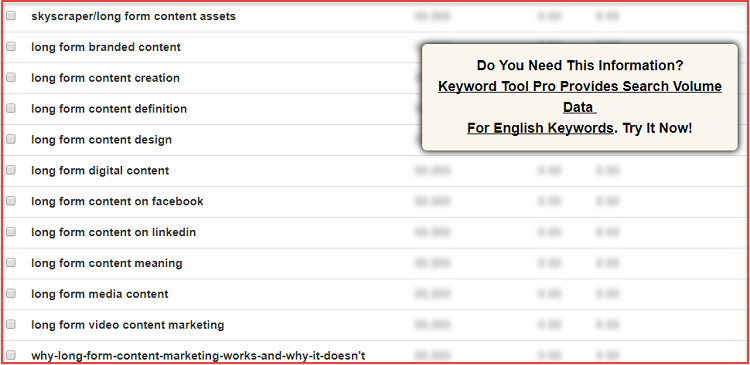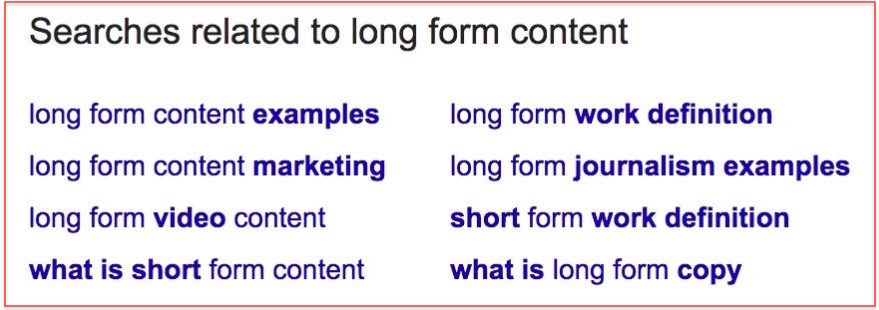Have you ever written a piece of long form content or eBook of 4000 words and above before?
If you haven’t, you probably don’t know the benefits and think that it’s just a lot of pointless work. But if you have, you already know that while it is indeed a lot of work, the result of that work can mean a great difference in search engine rankings. Earlier I wrote about two important things to make your long form content rank & many readers asked for more detailed guide on this and here we are.
Now, let’s say that you want to set up your own business. You lie awake every night terrified that your business might end up being a failure.
Then, one day, you see an A-Z guide for starting any business, and fortunately, this guide clears all your doubts and helps you to get started. This guide is loaded with all the information you need, and after devouring it, you begin to trust the people that created it.
So the next time you need to get anything for your business, like project management software, or advice on how to manage your work-life balance, you now have a trusted source to go to.
That is the benefit of creating informative, in-depth, long form content.
To put it succinctly, long form content will get you more of what you want from your blog – more visibility, improved engagement and social shares, more backlinks (which means higher ranking in SERPs), and most of all, it will make your audience start seeing you as the ultimate authority in your industry.
However, this post is not about the importance of long form content.
Instead, I’m here to share with you:
11 SEO Hacks For Creating & Ranking Long Form Content
1. Start With Keyword Research
Before writing your long form post, take the time to search for the best focus keyword on the topic, and also consider targeting a lower competition keyword.
Just ensure you carry out this step correctly because it will ultimately determine the success of your content in search engines.
There are many amazing tools on the internet that will make your keyword research task effortless.
Two of my favorites are:

Check out this post of the best tools for keyword research.
If you still don’t know how to carry out effective keyword research, check out the tutorials below:
- A Comprehensive Guide To Keyword Research By Juggernaut Method
- Keyword Forensics: Taking Your Keyword Research to the Next Level
- The Importance of Keywords in SEO: A Beginner’s Guide
2. Target Long Tail Keywords
Now, you already know that you should have a focus keyword while writing your long form blog post. But what a lot of people don’t know is that they should be targeting long tail keywords.
These are the type of keywords that get super specific on any topic. Long tail keywords are usually much easier to rank and drive in highly targeted traffic.
Below is an example of long tail keywords which I got from the popular keywordtool.io tool:

You can also use the same tool to gather as many long tail keywords as possible. But, if you’re having trouble coming up with more of such keywords, another good place to look at is the “related searches” section in Google:

For more on long tail keywords, check out these guides:
- Why Long Tail Keywords Is More Important Than Exact Match Keywords
- 6 Awesome Tools to Find Long-Tail Keywords In Any Niche
- Free LSI Keyword Research Tool To Rank Higher In Searches
3. Optimize and Clean Your URL
It’s been confirmed that cleaner and shorter URLs help search engines better understand what your post is talking about, and they also provide a better user experience.
Also, you want to ensure your URL contains your target keyword; this will enable it to rank better.

Short and concise is best.
Check out the guides below for a better understanding of URL structure:
- 15 SEO Best Practices for Structuring URLs
- 10 Useful Tips for Structuring URLs For Higher Ranking [Infographic]
4. Use A Proper H1 Tag
Your H1 tag will always be the first thing people see when they arrive at your blog posts.
Typically, your H1 tag is usually your blog post title.

A good H1 tag can significantly impact your search engine ranking.
The chart below shows the search engine ranking result gotten from a local car parts store in Houston, Texas after they changed some of their page titles and H1 tags:

A well optimized H1 tag will enable the search engines to better index your content.
Ideally, your H1 tags should:
- Be short and to the point.
- Provide a clear idea of what the blog post is about.
- Have a long tail keyword (your target keyword).
Once your headings have these qualities, you’re good to go.
For more on H1 tags and titles, check out:
- 7 Free Blog Post Title Generators & Analyzers for More Traffic
- 3 Easy To Use Tips for Writing Post Title For High Traffic
5. Add Good Subheadings
In an article posted on LinkedIn Pulse, Keren Lerner stated that “Your headlines may be catchy. Your writing may be amazing. You may have well-crafted words, punchy sentences, and incredible insight into the minds of your reader. But if your blog [post] is longer than 150 words, you need to add sub-headings – or build them in as you go!”
According to her, this is because, “big block of texts can feel like a chore to read.”
In case you don’t know, subheadings are the h2, h3, and h4 tags usually contained in a blog post.
Use subheadings to break up your content into easy to follow chunks. This will help your readers navigate and skim your content better.
For more on sub-headings, check out:
6. Add Inbound Links
Internal/inbound links refer to any links from one page on a website that points to another page on the same site. It’s one of the methods smart bloggers and content marketers use to tell Google and website visitors that a particular page of content is relevant.
There are many benefits associated with internal linking, some of which include:
- It helps to boost your ranking for certain keywords.
- It helps search engines easily crawl your site.
- It can help you to promote some paid services.
- It gives your audience further reading options.

For more on internal linking:
- 3 Best Solutions For Blog Posts Interlinking in WordPress
- What Are The Top Benefits of Interlinking Your Blog Posts?
7. Add Outbound Links
Just like inbound links, linking out to related pages in your niche tells Google that your page is of higher quality; it also helps search engines figure out your exact topic.
According to Brian from Backlinko, “Not linking out might be the #1 on-page SEO mistake that I see people make. I try to use 2-4x outbound links per 1000 words. That’s a good rule of thumb for most sites.”

For more on outbound links:
8. Optimize Your Title Tag
Title tags are incredibly essential; a properly optimized title tag will drastically enhance your page’s visibility in SERPs. They’re usually the very first thing people see when your content shows up in the search results.
For the sake of clarity, a title tag is the title of each result that comes up.
Here’s an example:

While writing your page’s title tag, ensure it contains your focus keyword and also describes the benefits the page offers.
For more on optimizing title tags, check out:
- How To Use WordPress Post Permalink & Post Title Combination for SEO
- WordPress Tags – What You Are Doing Wrong & How To Fix It
9. Optimize Your Meta Description For SEO
A meta description is a 160 character snippet that summarizes a page’s content.

Just like the title tag, your page’s meta description will enable your post to stand out in the search engine result pages.
A properly optimized meta description should:
- Include a focus keyword.
- Be brief (about 160 characters).
- Be crystal clear and descriptive.
- Contain a call-to-action (CTA).
- Be enchanting and entice the visitor to read the entire page.
For more on optimizing meta descriptions, check out:
- How To Write Meta Descriptions For SEO (with good and bad examples)
- How To Create The Right Meta Description
10. Include Multimedia
You already know that content marketing is not about just text. Text alone can only take you so far. Entertaining videos, images, screenshots, diagram, and charts can take you a lot further.
They will:
- Boost the time spent on your site.
- Reduce your bounce rate.
These are the two important user-interaction ranking factors that Google has been using to judge web pages recently.
You must have noticed that I often use a lot of images, charts, and screenshots on my blog posts; this is simply because I know the benefits they add to my content. Apart from boosting time on site and reducing bounce rate, they will also enhance the perceived value of the page, which will equally increase the likelihood of people linking to it.
Therefore, while writing your long form content, try and add as many relevant multimedia as possible.
For more on enhancing your page with multimedia, take a look at:
- How To Embed YouTube Videos in WordPress
- 20 Awesome Tools for Creating Engaging Visuals for Your Blog & Social Media
- 10 Absolutely Free Websites to Download Stock Images
11. Add Your Target Keyword And Related Keywords
It is important to include your focus keyword in the body of your blog post. However, you should not overdo things – just ensure it’s in there a few times.
This will make Google understand that your focus keyword is important while crawling your content.
Also, sprinkle in some related, low competition keywords throughout the content to enable you rank for even more focused long tail keywords.
Finally, it’s also advisable to mention your keyword toward the last paragraph of your article, and also in some of your subheadings. However, always remember to tread with caution and don’t over do it.
For more on adding in keywords, check out:
- What Is The Optimum Keyword Density for Better Ranking?
- Shattering The Myth About The Keyword Density Formula
Performing Proper SEO Of Long Form Content
Long form content is truly effective in positioning you as an authority on your topic, and also effective for enhancing your search engine ranking. However, this can only be achieved with solid SEO practices – like these 11 points.
Remember that this is not a complete list of everything needed to have a great SEO. These are merely the basics that will help you craft the best long form content on any topic.
Like you already know, search engine optimization is a long term strategy and not something you should expect seeing results in immediately.
In order for it to really have the best effect possible, you need patience.
Implement these techniques, and then watch, with patience, as your rankings skyrocket.
Do you have any more SEO ranking tips for long form content you’d like to share with us? Which one of these ranking tips do you often forget to implement? Share your thoughts with us in the comments below!
Like this post? Share it with your friends!
For further reading:
- How To Write Perfect SEO-Optimized Articles in WordPress
- A DIY Guide for WordPress Blog SEO: From Beginner to Pro
- How To Change Post URL of Already Published Post Without Losing Traffic
Subscribe on Youtube
Long Form Content SEO Ranking Strategy: 11 Must Follow Tips to Rank is a post from ShoutMeLoud - Shouters Who Inspires
from ShoutMeLoud https://ift.tt/2vHJXfU
More View at https://mwktutor.com
No comments:
Post a Comment